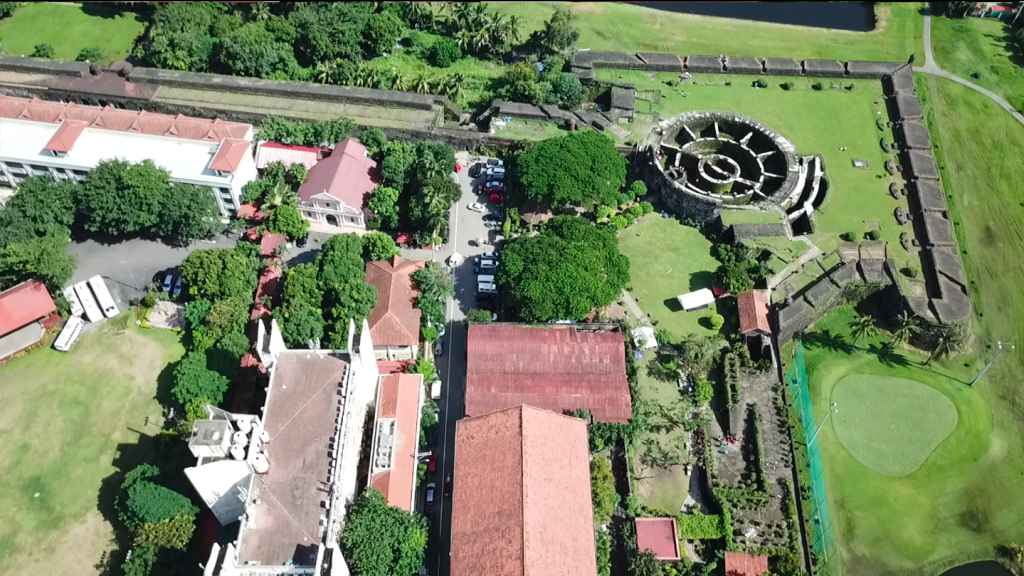Designed by the Jesuit priest and architect Antonio Sedeño and built from 1586-1587, the Fort Nstra. Sra. de Guia was a circular tower meant to defend Manila’s southern bayside boundary. In 1593, the upper portion of the tower was demolished after suffering from cracks. The rest of the structure was integrated into a new bulwark called Baluarte de San Diego. Completed sometime between 1653 and 1663, Baluarte de San Diego is shaped like an ace of spades. It was breached by the British forces with cannon fire in 1762, and was restored when the Spaniards returned. The earthquake of 1863 destroyed the structure, leading to its abandonment. During the American occupation, the circular fort was buried under layers of soil which eventually saved it from destruction during the Battle of Manila in 1945 despite the damage sustained by the baluarte containing it.

The circular fort was excavated in 1979 and the baluarte was restored by 1992. A garden was added at its base and the first stone fort in Manila is now an archeological park. The garden area – which was once the site of a foundry and soldier’s barracks – is today rented out for private functions.
The 16th century stone ruins provide a unique backdrop, while the fountain and pergola complete the perfect setting for special events and occasions.
Rizal Park
This vast greenbelt area outside the walls and south of Intramuros, is the Rizal Park, Luneta also known as Luneta Park. Rizal Park is Manila’s largest park, covering 58 hectares. The park used to be the site of Bagumbayan from the 16th to the 18th century. Bagumbayan was the settlement of the natives who once lived in Manila and relocated when Legazpi established Spanish Manila. The area became a seaside promenade during the 19th century and, simultaneously, an execution ground for the enemies of Spain. The park is named in honor of Dr. Jose Rizal, a nationalist and propagandist, who was executed in this place on December 30, 1896. In the 20th century, the area was developed into its present form. A monument, and a light and sound show of Rizal’s martyrdom could be seen in the park.
Rizal Park is also known by its Spanish period name Luneta Park, which comes from the name of a fortification, known as a lunette, that once stood in the area.
Other attractions near the Rizal Park include the National Museum Complex, the National Library, the Independence Flagpole, the Manila Hotel, and the Manila Ocean Park. The park is administered by the National Parks Development Committee.
Japanese Cannon
Over here is one of the few relics of the Battle of Manila popularly known as the Japanese cannon. This coastal defense and anti-aircraft gun was used against the American liberation forces and was abandoned after the war.
Golf Course and Driving Range
The grassy portion is the 18-hole Club Intramuros golf course operated by the Tourism Infrastructure and Enterprise Zone Authority (TIEZA, formerly Philippine Tourism Authority). Originally, this was part of the moat surrounding the entire perimeter of the Walled City. The entire moat was filled with earth during the American period and transformed into a golf course.
The western portion of the golf course is bounded by Bonifacio Drive. The street formed part of the shoreline of Manila Bay, and the land across was reclaimed during the American period to be the Port Area.
Manila Bay
This served as a natural defense of the Walled City. The original shoreline stretched from Bonifacio Drive to Roxas Boulevard along which can be found high-rise buildings that include the famous Manila Hotel. The Philippines is also proud of the Manila Bay sunsets.
Bagumbayan Light and Sound Museum
The museum was built by the Tourism Infrastructure and Enterprise Zone Authority (formerly Philippine Tourism Authority) and opened in 2003. This is located at the site of the Beaterio de la Compañia de Jesus (now Religious of the Virgin Mary), the first Filipino congregation of religious women, established in 1684, which moved out after their motherhouse was destroyed during the Battle of Manila in 1945.
The exhibit is a one-hour journey into Philippine history focusing on the heroism of Dr. Jose Rizal, narrated with video clips, light and sound effects, and moving mannequins. Aside from being entertained, a Filipino viewer becomes filled with a renewed sense of national pride, and a foreign visitor, with admiration for the Filipino heritage.
Watch our Virtual Tour!
Within the vast walls of Intramuros are several centuries-old fortifications. One of these is Baluarte de San Diego, a spade-shaped bulwark with a rich history. Walk with us inside this amazing place through #IntramurosVirtualTours launched in line with the Intramuros Administration’s “Travel From Home” campaign and in partnership with the Department of Tourism – Philippines.
For comments or questions contact us via [email protected]
#WeAreIntramuros

















